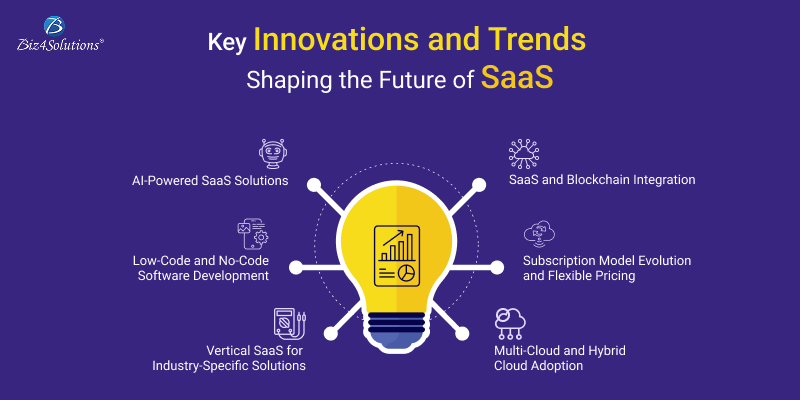
Why rely on a hard drive when access to the server is faster? Carrying around disconnected computers already feels outdated and inefficient.” – This visionary statement, made by the former Apple CEO, Steve Jobs, years before SaaS became mainstream, perfectly captures the essence of where software is headed: connectivity, agility,
and freedom from traditional infrastructure. Today, the Software-as-a-Service (SaaS) industry embodies that vision, evolving rapidly to meet shifting market demands and technological advancements.

As businesses prioritize scalability and cost-efficiency, SaaS providers are innovating with AI, blockchain, low-code/no-code platforms, and multi-cloud strategies. At the same time, a new movement is reshaping the ecosystem: micro
SaaS. It refers to small, highly focused Software-as-a-Service products, usually built and run by a solo founder or a very small team. Unlike large SaaS platforms that aim to serve broad markets, micro-SaaS tools solve a single,
niche problem for a very specific audience.
Interesting Stats on SaaS
As per Fortune Business Insights:
- By 2023, 70% of businesses were leveraging SaaS applications.
- The SaaS market was valued at $266.23 Billion in 2024; and is forecasted to reach $1,131.52 Billion by 2032 (CAGR: 20%).
- Micro-SaaS is gaining momentum and continues to rise in popularity.
These figures highlight not only the immense growth of SaaS but also the opportunity for micro-SaaS ventures to thrive within this booming ecosystem.
1. AI-Powered SaaS Solutions
AI continues to transform SaaS by powering automation, data analytics, and decision-making. AI-driven platforms are now delivering predictive analytics, intelligent
automation, and personalized experiences across sectors like healthcare, finance, and e-commerce.
Key AI Trends in SaaS:

- Virtual assistants and chatbots enhancing customer support.
- Machine learning powering personalized user experiences.
- Predictive analytics aiding business forecasting.
- AI-driven cybersecurity for real-time threat detection.
Micro-SaaS Spotlight: Small teams and solo founders are building AI-driven tools—like niche dashboards, chatbots, and automation apps—that solve one problem exceptionally well for a focused audience.
2. Low-Code and No-Code Software Development
With low-code and no-code platforms on the rise, businesses can launch and customize apps faster—giving non-technical teams the power to create and modify solutions with ease.
Benefits:
- Faster development cycles.
- Lower dependency on IT teams.
- Rapid prototyping and iteration.
- Better collaboration between business and developers.
icro SaaS Angle: Many micro-SaaS startups leverage these platforms to get products to market quickly, with minimal resources, and iterate based on early feedback.
3. Vertical SaaS and Micro SaaS for Industry-Specific Solutions
While traditional horizontal SaaS platforms cater to broad markets, vertical SaaS hones in on specific industries such as healthcare, finance, or retail. Micro SaaS takes specialization a step further, delivering focused,
single-purpose solutions designed to do one thing exceptionally well.
Growth Examples:
- Financial Contact Center Software: AI-enhanced tools handling customer workflows and interactions.
- Healthcare SaaS: Cloud-based EHRs that streamline patient care and compliance.
- E-commerce SaaS: AI-powered recommendation systems improving personalized shopping.
Concrete Micro SaaS Illustration — Number Sentry: An AI-powered outbound-calling solution tailored specifically for financially focused contact centers,
Number Sentry optimizes connect rates by diagnosing outbound call challenges, selecting optimal call routes, and mitigating call blocking or spam labeling. It comprises five distinct components—Number Guard, Recon, Mapper,
Shield, and Defender—offering analytics-driven insights into call deliverability and carrier performance.
This example illustrates how a highly specialized tool—though substantial in its impact—can embody the micro-SaaS ethos by solving a very specific niche without a bloated scope.
4. SaaS and Blockchain Integration
Blockchain is increasingly shaping SaaS by delivering stronger security, greater transparency, and tamper-proof records.
Benefits:
- Improved data security and privacy.
- Smart contracts facilitating automated workflows.
- Decentralized storage reinforcing data integrity.
Micro-SaaS Potential: Niche offerings—like blockchain-verified document tools, decentralized compliance utilities, or secure ID plugins—are emerging as lightweight micro SaaS solutions addressing complex needs.
5. Subscription Model Evolution and Flexible Pricing
As the space gets crowded, pricing strategies are shifting toward value-driven, flexible approaches like usage-based billing and tiered freemium models.
Trends:
- Pay-as-you-go models for cost-sensitive users.
- Customizable subscription tiers.
- Outcome-based pricing that aligns with business value delivered.
Micro-SaaS Fit: Most micro SaaS ventures succeed with ultra-affordable subscriptions, offering high-value, low-risk solutions for small businesses and entrepreneurs while generating steady recurring revenue.
6. Multi-Cloud and Hybrid Cloud Adoption
Enterprises are turning to multi-cloud and hybrid strategies to maximize flexibility and prevent vendor lock-in, driving SaaS platforms to support seamless cross-cloud integration.
Advantages:
- Better scalability and uptime.
- Superior disaster recovery.
- Optimized workload allocation.
Micro SaaS Opportunity: There’s growing demand for niche tools that help monitor, optimize, or manage these multi-cloud setups—ripe for micro SaaS applications in management and integration.
Key Takeaways
SaaS continues to evolve at lightning speed, fueled by AI, blockchain, low-code development, and advanced cloud strategies. But the true revolution might just be happening with micro SaaS—lean, targeted tools built by solo teams,
solving one vital problem with laser focus and agility.
As the projected SaaS market edges toward $1,131.52 billion, it’s clear—micro SaaS isn’t just a side hustle; it’s a sustainable, intelligent path to impact. From Number Sentry’s laser-sighted approach to tailored
contact center analytics to low-cost, high-efficiency tools, sometimes small is smarter in software innovation.
